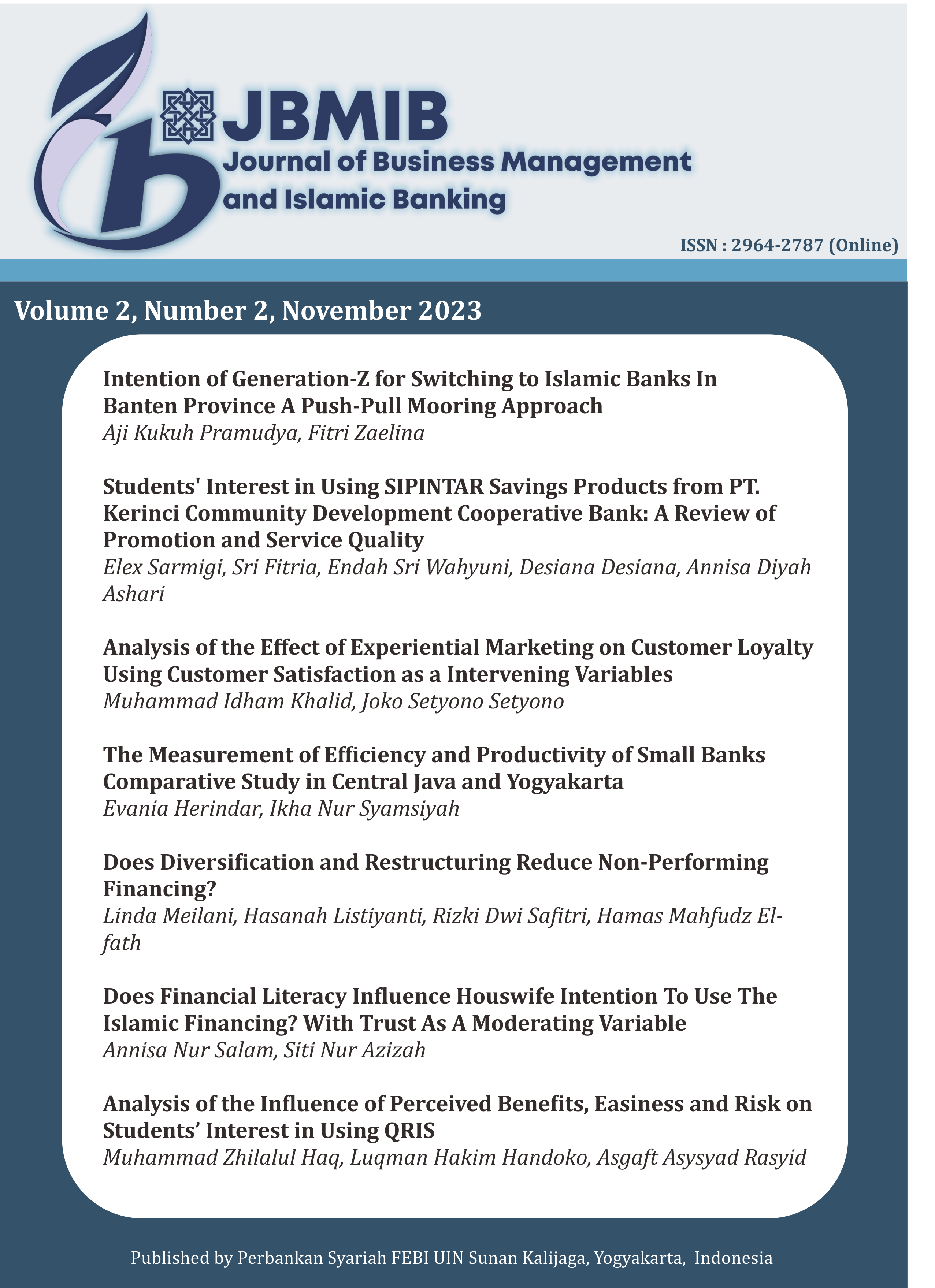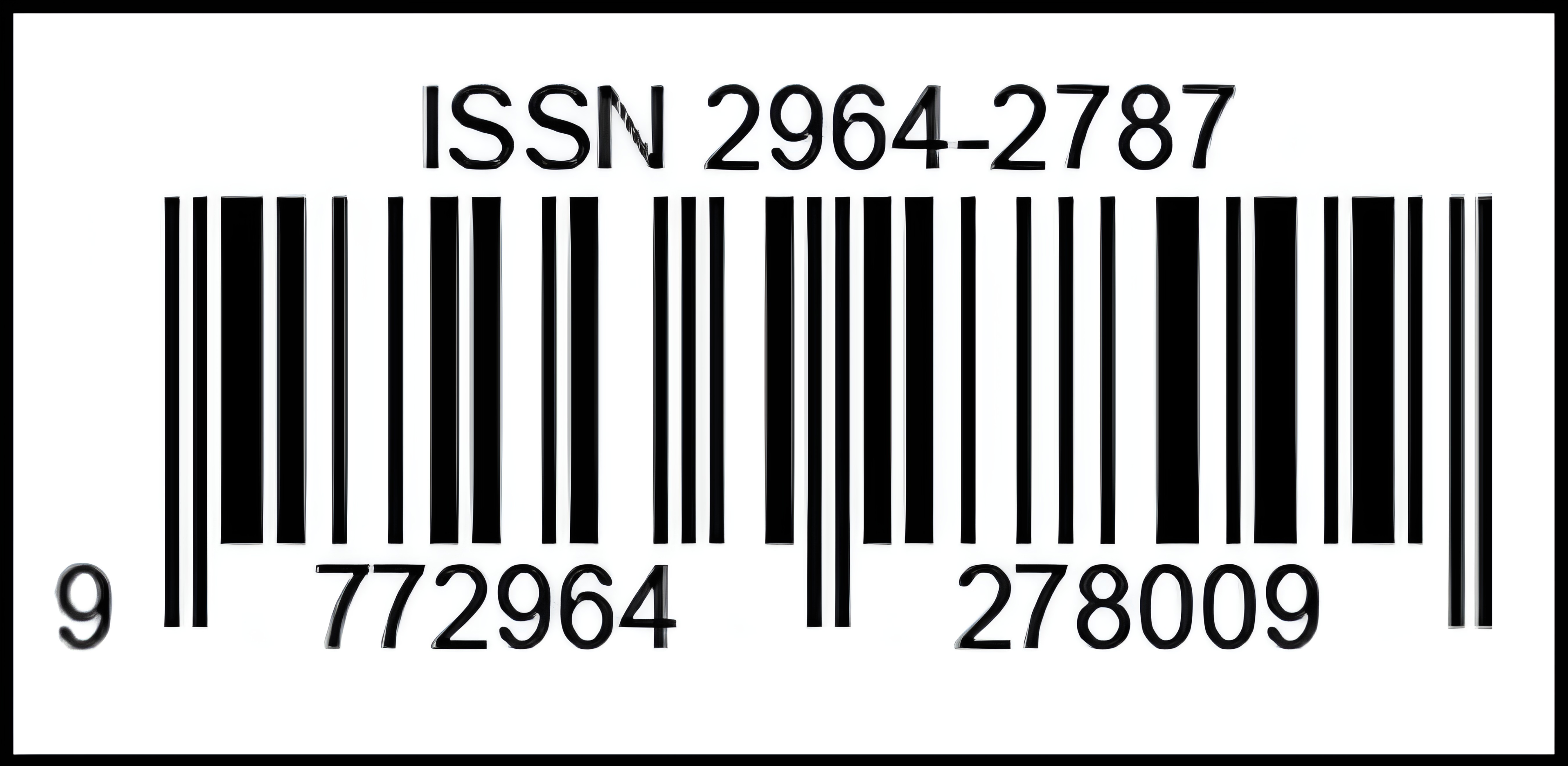Intention of Generation-Z for Switching to Islamic Banks In Banten Province A Push-Pull Mooring Approach
DOI:
https://doi.org/10.14421/jbmib.v2i02.2028Keywords:
PPM, Push-Pull Mooring, Switching Intention, Islamic Banking, Generation ZAbstract
Research Aims: The purpose of this research is to understand the interest of Generation Z in switching behavior to Islamic banks based on the Push Pull Mooring (PPM) theory.
Methodology: The method used in this research is quantitative and the population taken as a sample is Generation Z in Banten Province. The hypothesis in this research is tested using Structural Equation Modelling (SEM) and the SmartPLS 3.0 application, with a sample size of 184 respondents taken using purposive sampling method.
Research Findings: The results of the research show that the push and pull factors have a positive and significant effect on switching intention, while the mooring factors do not have an effect on switching intention.
Theoretical Contribution/Originalitity: The research focuses on Generation Z in Banten Province, and the findings may not be generalized to other regions or age groups. Additionally, the study relies on self-reported data, which may be subject to respondent bias.
Implication: Sharia banks must take the opportunity to develop and offer services that are more in line with religious values and can focus on developing products and services that meet sharia standards and prioritize Islamic ethical values to attract more customers.
Downloads
 Abstract viewed: 217 times
|
Abstract viewed: 217 times
|
 PDF downloaded = 450 times
PDF downloaded = 450 times
References
Adhi004. (2022). Wapres Minta MES Kerja Cepat dan Kompak. Kominfo.Go.Id. https://www.kominfo.go.id/content/detail/44800/wapres-minta-mes-kerja-cepat-dan-kompak/0/berita#:~:text=Jakarta Pusat%2C Kominfo – Perkembangan ekonomi,angka 10%25 di tahun sebelumnya.
Badan Pusat Statistik Kabupaten Lebak. (2022). Jumlah Penduduk Menurut Kelompok Umur (Jiwa), 2020. BADAN PUSAT STATISTIK KABUPATEN LEBAK. Badan Pusat Statistik Kabupaten Lebak. https://lebakkab.bps.go.id/indicator/12/82/1/jumlah-penduduk-menurut-kelompok-umur.html
Bank Indonesia. (2021). Laporan Ekonomi dan Keuangan Syariah 2021.
Bansal, H. S., Taylor, S. F., & James, Y. S. (2005). “Migrating” to new service providers: Toward a unifying framework of consumers’ switching behaviors. Journal of the Academy of Marketing Science, 33(1), 96–115. https://doi.org/10.1177/0092070304267928
BSI. (2021). Laporan Tahunan 2021: Energi Baru untuk Indonesia. In PT Bank Syariah Indonesia, Tbk.
Ganesh, J., Arnold, M. J., & Reynolds, K. E. (2000). Understanding the customer base of service providers: An examination of the differences between switchers and stayers. Journal of Marketing, 64(3), 65–87. https://doi.org/10.1509/jmkg.64.3.65.18028
Hardani, Auliya, N. H., Andriani, H., Fardani, R. A., Ustiawaty, J., Utami, E. F., Sukmana, D. J., & Istiqomah, R. R. (2020). Buku Metode Penelitian Kualitatif dan Kuantitatif (H. Abadi (ed.); 1st ed., Issue march). CV. Pustaka Ilmu.
Hsieh, J. K., Hsieh, Y. C., Chiu, H. C., & Feng, Y. C. (2012). Post-adoption switching behavior for online service substitutes: A perspective of the push-pull-mooring framework. Computers in Human Behavior, 28(5), 1912–1920. https://doi.org/10.1016/j.chb.2012.05.010
Joseph F. Hair, J., Hult, G. T. M., Ringle, C. M., & Sastedt, M. (2017). A Primer on Partial Least Squares Structural Equation Modeling (PLS-SEM). Thousand Oaks. In Sage.
Jung, J., Han, H., & Oh, M. (2017). Travelers’ switching behavior in the airline industry from the perspective of the push-pull-mooring framework. Tourism Management, 59, 139–153. https://doi.org/10.1016/j.tourman.2016.07.018
Keaveney, S. M., & Parthasarathy, M. (2001). Customer switching behavior in online services: An exploratory study of the role of selected attitudinal, behavioral, and demographic factors. Journal of the Academy of Marketing Science, 29(4), 374–390. https://doi.org/10.1177/03079450094225
KNKS. (2020). TREND KONVERSI KE BANK SYARIAH. Komite Nasonal Dan Keuangan Syariah, 9, 18. https://knks.go.id/satu-pusatdata/7?page=5
Lai, J. Y., Debbarma, S., & Ulhas, K. R. (2012). An empirical study of consumer switching behaviour towards mobile shopping: A Push-Pull-Mooring model. International Journal of Mobile Communications, 10(4), 386–404. https://doi.org/10.1504/IJMC.2012.048137
Lee, K. C., & Chung, N. (2009). Understanding factors affecting trust in and satisfaction with mobile banking in Korea: A modified DeLone and McLean’s model perspective. Interacting with Computers, 21(5–6), 385–392. https://doi.org/10.1016/j.intcom.2009.06.004
Mannheim, K. (1952). The Problem of Generations. Essays on the Sociology of Knowledge (Vol. 1, Issue 12).
Morgan, R. M., & Hunt, S. D. (1994). The Commitment-Trust Theory of. Journal of Marketing, 58(July), 20–38. https://journals.sagepub.com/doi/full/10.1177/002224299405800302
Roos, I., Edvardsson, B., & Gustafsson, A. (2004). Customer switching patterns in competitive and noncompetitive service industries. Journal of Service Research, 6(3), 256–271. https://doi.org/10.1177/1094670503255850
Sholihin, M., & Ratmono, D. (2020). Analisis SEM-PLS dengan WarpPLS 7.0 untuk Hubungan Nonlinier dalam Penelitian Sosial dan Bisnis (C. Mitak (ed.); I). PENERBIT ANDI (Anggota IKAPI). https://books.google.co.id/books?id=NbMWEAAAQBAJ&printsec=copyright#v=onepage&q&f=false
Sujarweni, V. W. (2014). Metode Penelitian: Lengkap, Praktis, dan Mudah Dipahami. Pustaka Baru Press.
Sun, Y., Liu, D., Chen, S., Wu, X., Shen, X. L., & Zhang, X. (2017). Understanding users’ switching behavior of mobile instant messaging applications: An empirical study from the perspective of push-pull-mooring framework. Computers in Human Behavior, 75, 727–738. https://doi.org/10.1016/j.chb.2017.06.014
Supardi. (1993). Populasi dan Sampel Penelitian. Unisia, 13(17), 100–108. https://doi.org/10.20885/unisia.vol13.iss17.art13
Yoon, C., & Lim, D. (2021). Customers’ intentions to switch to internet-only banks: Perspective of the push-pull-mooring model. Sustainability (Switzerland), 13(14), 1–20. https://doi.org/10.3390/su13148062
Zhou, T., & Lu, Y. (2011). Examining mobile instant messaging user loyalty from the perspectives of network externalities and flow experience. Computers in Human Behavior, 27(2), 883–889. https://doi.org/10.1016/j.chb.2010.11.013
Downloads
Published
How to Cite
Issue
Section
License
Copyright (c) 2023 Journal of Business Management and Islamic Banking

This work is licensed under a Creative Commons Attribution-NonCommercial 4.0 International License.












